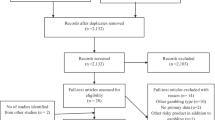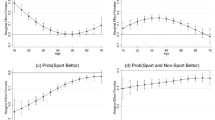Serious sport is war minus the shooting
George Orwell
Abstract
This study focuses on the determinants of self-reported measures of national pride. Using pooled cross-sectional data for European countries obtained from the Eurobarometer, it is estimated that pride is not correlated with GDP per capita nor with household income levels. Using the 2000 UEFA European Championship as a natural experiment, it is estimated that individuals from both host and winning nations report, on average, higher levels of national pride in the period immediately following the event, supporting theoretical arguments of a “feel-good” factor associated with sports events. Accounting for performance relative to expectations produces results along the same lines.
Similar content being viewed by others
Notes
Note that although life satisfaction and happiness are separable constructs, previous research in the economics literature treats them as variants of the same notion and uses them interchangeably (Frey and Stutzer 2002; Di Tella et al. 2003; Blanchflower and Oswald 2004; Easterlin 2005, 2006; Di Tella and MacCulloch 2006).
For a recent overview see Frey and Stutzer (2002).
“Don’t know” answers are not studied here.
In fact, the Eurobarometer surveys ceased asking questions regarding the income status of individuals and their household as of 2004.
The life satisfaction question is: “On the whole, are you very satisfied, fairly satisfied, not very satisfied or not at all satisfied with the life you lead?”. Note that over the pooled sample the correlation coefficient between national pride and life satisfaction is 0.14, implying that the two scales measure different, though positively related, aspects. Arguably, life satisfaction provides a more general picture of subjective well-being, whereas national pride measures a specific emotion within the former (Oishi et al. 2003).
Where note that in the post-event surveys the correlation between pride and life satisfaction for participating nations is equal to 0.215.
References
Baade, R., & Matheson, V. A. (2002). Bidding for the olympics: Fool’s gold? In C. Barros, M. Ibrahim, & S. Szymanski (Eds.), Transatlantic sports. Cheltenham: Edward Elgar.
Blanchflower, D. G., & Oswald, A. J. (2004). Well-being over time in Britain and the USA. Journal of Public Economics, 88, 1359–1386.
Borusiak, L. (2009). Soccer as a catalyst of patriotism. Sociological Research, 48(4), 57–81.
Cheng, J. T., Tracy, J. L., & Henrich, J. (2010). Pride, personality, and the evolutionary foundations of human social status. Evolution and Human Behavior, 31, 334–347.
Crompton, J. L. (1995). Economic impact analysis of sports facilities and events: Eleven sources of misapplication. Journal of Sport Management, 9, 14–35.
Di Tella, R., & MacCulloch, R. (2006). Some uses of happiness data in economics. Journal of Economic Perspectives, 20(1), 25–46.
Di Tella, R., MacCulloch, R., & Oswald, A. (2003). The macroeconomics of happiness. Review of Economics and Statistics, 85(4), 809–827.
Dolan, P., Peasgood, T., & White, M. (2008). Do we really know what makes us happy? A review of the economic literature on the factors associated with subjective well-being. Journal of Economic Psychology, 29, 94–122.
Easterlin, R. A. (1974). Does economic growth improve the human lot? Some empirical evidence. In P. A. David & M. W. Reder (Eds.), Nations and households in economic growth: Essays in honor of Moses Abramowitz, 89–125. New York: Academic Press.
Easterlin, R. A. (2005). Building a better theory of well-being. In L. Bruni & P. Porta (Eds.), Economics and happiness: Framing the analysis, (29–64). Oxford: Oxford University Press.
Easterlin, R. A. (2006). Life cycle happiness and its sources: Intersections of psychology, economics, and demography. Journal of Economic Psychology, 27, 463–482.
Frey, B. S., & Stutzer, A. (2002). What can economists learn from happiness research? Journal of Economic Literature, 40(2), 402–435.
Hopkins, N. (2001). National identity: Pride and prejudice? British Journal of Social Psychology, 40(2), 183–186.
Joiner, T. E., Hollar, D., & van Orden, K. (2006). On Buckeyes, Gators, super bowl Sunday, and the miracle on ice: “Pulling together” is associated with lower suicide rates. Journal of Social and Clinical Psychology, 25(2), 179–195.
Kavetsos, G., & Szymanski, S. (2010). National wellbeing and international sports events. Journal of Economic Psychology, 31(2), 158–171.
Kimball, M., Levy, H., Ohtake, F., & Tsutsui, Y. (2006). Unhappiness after hurricane Katrina, NBER, Working Paper 12062.
Luttmer, E. (2005). Neighbors as negatives: Relative earnings and well-being. Quarterly Journal of Economics, 120(3), 963–1002.
Manzenreiter, W., & Horne, J. (2005). Public policy, sports investments and regional development initiatives in Japan. In J. Nauright & S. Schimmel (Eds.), The political economy of sport. Palgrave MacMillan.
Moaddel, M., Tessler, M., & Inglehart, R. (2008). Foreign occupation and national pride: The case of Iraq. Public Opinion Quarterly, 72(4), 677–705.
Müller-Peters, A. (1998). The significance of national pride and national identity to the attitude toward the single European currency: A Europe-wide comparison. Journal of Economic Psychology, 19, 701–719.
Neumann, R., Steinhäuser, N., & Roeder, U. T. (2009). How self-construal shapes emotion: Cultural differences in the feeling of pride. Social Cognition, 27(2), 327–337.
Oishi, S., Schimmack, U., & Colcombe, S. J. (2003). The contextual and systematic nature of life satisfaction judgements. Journal of Experimental Social Psychology, 39, 232–247.
Oswald, A. J. (1997). Happiness and economic performance. Economic Journal, 107(445), 1815–1831.
Oswald, A. J., & Powdthavee, N. (2008). Does happiness adapt? A longitudinal study of disability with implication for economists and judges. Journal of Public Economics, 92(5–6), 997–1019.
Riordan, J. (1987). Sports medicine in the soviet union and German democratic republic. Social Science and Medicine, 25(1), 19–26.
Rose, R. (1985). National pride in cross-national perspective. International Social Science Journal, 37(1), 85–96.
Siegfried, J., & Zimbalist, A. (2000). The economics of sports facilities and their communities. Journal of Economic Perspectives, 14(3), 95–114.
Smith, T. W., & Kim, S. (2006). National pride in cross-national and temporal perspective. International Journal of Public Opinion Research, 18, 127–136.
Steels, M. D. (1994). Deliberate self-poisoning: Nottingham forest football club and F.A. cup defeat. Irish Journal of Psychological Medicine, 11(2), 76–78.
Stevenson, B., & Wolfers, J. (2008). Economic growth and subjective well-being: Reassessing the Easterlin paradox. Brookings Papers on Economic Activity, Spring 2008, 1–87.
Tracy, J. L., Cheng, J. T., Robins, R. W., & Trzesniewski, K. H. (2009). Authentic and Hubristic pride: The affective core of self-esteem and narcissism. Self and Identity, 8, 196–213.
Tracy, J. L., & Robins, R. W. (2007). The psychological structure of pride: A tale of two facets. Journal of Personality and Social Psychology, 92(3), 506–525.
Trovato, F. (1998). The stanley cup of hockey and suicide in Quebec, 1951–1992. Social Forces, 77, 105–127.
Winkelmann, L., & Winkelmann, R. (1998). Why are the unemployed so unhappy? Evidence from panel data. Economica, 65(257), 1–15.
Witte, D. R., Bots, M. L., Hoes, A. W., & Grobbee, D. E. (2000). Cardiovascular mortality in Dutch men during 1996 European football championship: Longitudinal population study. British Medical Journal, 321, 1552–1554.
Wooldridge, J.M. (2002). Econometric analysis of cross section and panel data. The MIT Press.
Acknowledgments
I would like to thank Nick Powdthavee, Stefan Szymanski, the editor and an anonymous referee for valuable comments and suggestions in previous versions of this study.
Author information
Authors and Affiliations
Corresponding author
Rights and permissions
About this article
Cite this article
Kavetsos, G. National Pride: War Minus the Shooting. Soc Indic Res 106, 173–185 (2012). https://doi.org/10.1007/s11205-011-9801-1
Accepted:
Published:
Issue Date:
DOI: https://doi.org/10.1007/s11205-011-9801-1




